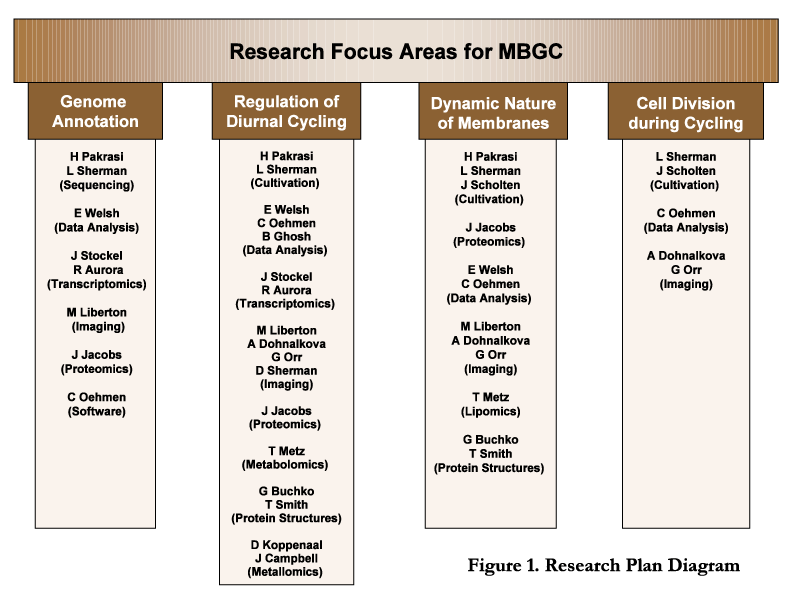C. Scientific Aims and Research Plan
Membrane processes are critical to solving highly complex problems related to energy production, carbon sequestration, bioremediation, and other problems of national interest in energy and environmental science. Understanding how membrane processes fit into the overall cellular physiology and ecology requires a systems-level analysis of the genetics, biochemistry, and biophysics of membrane components and how molecular machines assemble, function, and disassemble as a function of time. EMSL’s signature characteristics and capabilities provide enabling technologies to examine complex biological processes, with new computational and experimental tools to provide an integrated and predictive understanding of how an organism behaves and responds to environmental changes.
Cyanothece is a marine cyanobacterium capable of oxygenic photosynthesis, nitrogen fixation, and heterotrophic growth in the dark. This unicellular organism has evolved an elaborate circadian rhythm to use time to separate the peaks of nitrogen-fixation from the peaks of oxygen production during oxygenic photosynthesis because of the oxygen-sensitive nature of the nitrogenase enzyme. The diurnal patterns of nitrogen-fixation in the dark and photosynthesis in the light make Cyanothece a unique model organism for studying solar energy harvesting, carbon sequestration, metal acquisition, and hydrogen production.
The objective of this program is to use systems biology approaches to determine the underlying cell signaling networks which govern the functions of cyanobacterial membranes and their components to accomplish the dramatic diurnal cycling. The successful implementation of such an approach requires collaborative interactions among multidisciplinary teams of biologists, chemists, physicists, engineers, mathematicians, and computer scientists. The four primary research focus areas in the Grand Challenge are:
- Proteomics-Assisted Genome Annotation: Are there unique genetic elements that explain the regulation of cell processes that govern diurnal cycling? How do you assign functional annotation to predicted novel proteins with little informative sequence homology?
- Temporal Regulation of Cell Processes during Diurnal Cycling: How does the transcriptome and metabolome of cyanobacteria respond to environmental changes such as light intensity, CO2 level, metal concentrations and circadian rhythm?
- Dynamic Nature of Cell Membranes: How does the cyanobacterial membrane proteome change under similar perturbations, and how well does that relate to the transcriptome? What is the relationship between plasma membrane and thylakoid membrane in cyanobacteria?
- Regulation of Cell Division during Diurnal Cycling: How does cell age effect nitrogenase activity in the mixed populations of a bioreactor? Can we see signs of asymmetric cell division during cycling and how does this type of cell division correlate with the rate of N2-fixation?

The cross-cutting technologies employed by the collaborators on the MBGC team span across all of the research focus areas. Therefore, the following technical report topics will form the basis of a series of subproject teams:
| H. Pakrasi | Systems Analysis of the Dynamics of Membrane Architecture, Composition, and Function |
| L Sherman |
Analyses of the Unicellular, Diazotrophic Cyanobacterium Cyanothece sp ATCC 51142: Genetics, Imaging and Metabolic Rhythms during Growth in a 6-L Bioreactor |
| J Scholten | Ecophysiological Investigation of Cyanobacteria Using Controlled Cultivation |
| A Dohnalkova | Morphological, Functional and Redox Studies of Synechocystis 6803 and Cyanothece 51142 sp. Bacterial Membrane Complexes by Methods of Electron Microscopy |
| G Orr | Dynamic Changes in Molecular Expressions and Interactions along the Circadian Rhythm |
| J Jacobs | Systems Analysis of the Dynamics of Membrane Architecture, Composition, and Function: Proteomic, Metabolomic, and Metallomic Characterization |
| T Smith | Structural Analysis of Membrane-Associated Proteins |
| G Buchko | First Protein Structures from Cyanothece 51142 |
| R Aurora |
Transcriptional Profiling and Computational Modeling |
| C Oehmen | Computational Biology and Bioinformatics Tools for Understanding the Role of Membrane Proteins in Diurnal and Circadian Processes of Prokaryotes |
| E Peterson |
Data Assimilation, Visualization, and Mining |
